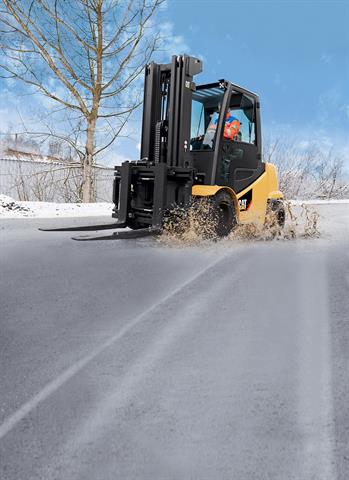 It's time to start preparing yourself, your staff, equipment and operating areas for the winter season and the harsher conditions it brings. |
Here are our top 10 forklift safety tips for the winter season.Preparing your operating areas1) Grit your operating areasIf you have outside areas in which you operate, make sure these are gritted in the winter months. With the increased likelihood of icy conditions, your forklift will be more susceptible to accidents if operating areas haven't been properly gritted.
Preparing, maintaining and operating your forklift2) Protect your forklift from the elementsIf your forklift is used outdoors, or both inside and out, you'll need to keep it protected in the winter months. If your lift truck doesn't have an enclosed cabin, make sure you invest in a forklift cover to protect your truck from harsh weather conditions when not in use.
3) Check the forklift for visible damage before useIt's important to keep a close eye on your forklift during the winter months as harsh weather conditions can cause damage which could lead to accidents. Ensure your forklift is being checked for visible damage each time it is used, as any issues that arise could be amplified by the bad weather.
4) MaintenanceDuring the winter months, there is more demand on the key components of your forklift truck. A regular and thorough maintenance programme will keep your forklift running and operating efficiently even in treacherous conditions.
5) Monitor fluidsAny vehicle, in colder weather, will be exposed to the possibility of liquids becoming frozen. That includes your lift trucks. Although forklift engines are designed to be extremely durable, sometimes unusually cold weather can cause issues.
Diesel, in particular, can become jelly-like in extremely cold temperatures. This can have an impact on the performance of the machine, and more seriously, can cause expensive and sometimes irreversible damage. Make sure you check your fluids before using your machine.
6) Prepare your tyresAs well as gritting outside areas, it's also a good idea to give your tyres more grip. Tyre chains or studs are a great way to keep the forklift, and driver, safe in icy and snowy conditions.
7) Allow the forklift to warm up before useAllowing the forklift to warm up properly is important for both the engine and the hydraulics. Not allowing your forklift to warm up properly before use can increase wear and tear as well as fuel consumption.
Preparing yourself and your colleagues8) Plan in advanceThe winter season comes around so quickly, that it's easy to get caught out. It may seem counter intuitive to start planning for winter when the weather is still warm and the sun is shining, but in doing so, you'll ensure that everything runs smoothly and efficiently during the winter season.
Ensure you and your team are up to date with cold weather driving procedures and general forklift safety knowledge. It's also advisable to have a winter plan in place that all of your team are aware of.
9) Drive with cautionWhen operating your forklift, drive with caution. Ensure you are only going as fast as the conditions deem safe. Visibility may also be impaired, so use your front and rear lights, keep windows clear and make sure you are fully alert when operating the machine.
10) Wrap up warmEnsure you have appropriate winter clothing including a hat, gloves and a jacket. Being overly cold can impact your responses and distract you from the task at hand. Ensure, where appropriate, you also have hi-vis clothing so when visibility is impaired, you can still be seen.
To download our winter safety checklist, click
here.
For general forklift operation safety tips, check out our
forklift safety video guide.
For tips on loading and unloading your forklift, in any condition, check out
this recent article.
And don't forget to browse our full range of counterbalance forklift trucks
here.
Cat® Lift Trucks
www.catlifttruck.com
Send an email